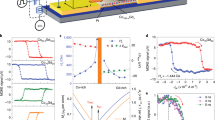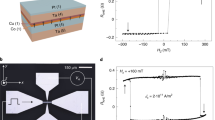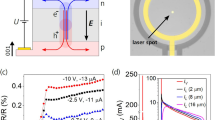Abstract
Exploration of spin currents in organic semiconductors (OSECs) induced by resonant microwave absorption in ferromagnetic substrates is appealing for potential spintronics applications. Owing to the inherently weak spin–orbit coupling (SOC) of OSECs, their inverse spin Hall effect (ISHE) response is very subtle; limited by the microwave power applicable under continuous-wave (cw) excitation. Here we introduce a novel approach for generating significant ISHE signals in OSECs using pulsed ferromagnetic resonance, where the ISHE is two to three orders of magnitude larger compared to cw excitation. This strong ISHE enables us to investigate a variety of OSECs ranging from π-conjugated polymers with strong SOC that contain intrachain platinum atoms, to weak SOC polymers, to C60 films, where the SOC is predominantly caused by the curvature of the molecule’s surface. The pulsed-ISHE technique offers a robust route for efficient injection and detection schemes of spin currents at room temperature, and paves the way for spin orbitronics in plastic materials.
This is a preview of subscription content, access via your institution
Access options
Subscribe to this journal
Receive 12 print issues and online access
$259.00 per year
only $21.58 per issue
Buy this article
- Purchase on Springer Link
- Instant access to full article PDF
Prices may be subject to local taxes which are calculated during checkout




Similar content being viewed by others
References
Kuschel, T. & Reiss, G. Spin orbitronics: charges ride the spin wave. Nature Nanotech. 10, 22–24 (2014).
Hirsch, J. E. Phys. Spin Hall effect. Phys. Rev. Lett. 83, 1834–1837 (1999).
Valenzuela, S. O. & Tinkham, M. Direct electronic measurement of the spin Hall effect. Nature 442, 176–179 (2006).
Kato, Y. K., Myers, R. C., Gossard, A. C. & Awschalom, D. D. Observation of the Spin Hall effect in semiconductors. Science 306, 1910–1913 (2004).
Saitoh, E. et al. Conversion of spin current into charge current at room temperature: inverse spin-Hall effect. Appl. Phys. Lett. 88, 182509 (2006).
Costache, M., Sladkov, M., Watts, S., van der Wal, C. & van Wees, B. Electrical detection of spin pumping due to the precessing magnetization of a single ferromagnet. Phys. Rev. Lett. 97, 216603 (2006).
Kimura, T., Otani, Y., Sato, T., Takahashi, S. & Maekawa, S. Room-temperature reversible spin Hall effect. Phys. Rev. Lett. 98, 156601 (2007).
Kajiwara, Y. et al. Transmission of electrical signals by spin-wave interconversion in a magnetic insulator. Nature 464, 262–266 (2010).
Ando, K. et al. Electrically tunable spin injector free from the impedance mismatch problem. Nature Mater. 10, 655–659 (2011).
Rojas-Sánchez, J. C. et al. Spin pumping and inverse spin Hall effect in platinum: the essential role of spin-memory loss at metallic interfaces. Phys. Rev. Lett. 112, 106602 (2014).
Mosendz, O. et al. Detection and quantification of inverse spin Hall effect from spin pumping in permalloy/normal metal bilayers. Phys. Rev. B 82, 214403 (2010).
Morota, M. et al. Indication of intrinsic spin Hall effect in 4d and 5d transition metals. Phys. Rev. B 83, 174405 (2011).
Wang, H. et al. Scaling of spin Hall angle in 3d, 4d, and 5d metals from/metal spin pumping. Phys. Rev. Lett. 112, 197201 (2014).
Du, C., Wang, H., Yang, F. & Chris Hammel, P. Systematic variation of spin-orbit coupling with d-orbital filling: large inverse spin Hall effect in 3d transition metals. Phys. Rev. B 90, 140407(R) (2014).
Ando, K. & Saitoh, E. Observation of the inverse spin Hall effect in silicon. Nature Commun. 3, 629 (2012).
Shikoh, E. et al. Spin-pump-induced spin transport in p-type Si at room temperature. Phys. Rev. Lett. 110, 127201 (2013).
Tang, Z. et al. Dynamically generated pure spin current in single-layer graphene. Phys. Rev. B 87, 140401 (2013).
Ohshima, R. et al. Observation of spin-charge conversion in chemical-vapor-deposition-grown single-layer graphene. Appl. Phys. Lett. 105, 162410 (2014).
Ando, K., Watanabe, S., Mooser, S., Saitoh, E. & Sirringhaus, H. Solution-processed organic spin-charge converter. Nature Mater. 12, 622–627 (2013).
Watanabe, S. et al. Polaron spin current transport in organic semiconductors. Nature Phys. 10, 308–313 (2014).
Ando, K. et al. Inverse spin-Hall effect induced by spin pumping in metallic system. J. Appl. Phys. 109, 103913 (2011).
Jiao, H. & Bauer, G. E. W. Spin backflow and ac voltage generation by spin pumping and the inverse spin Hall effect. Phys. Rev. Lett. 110, 217602 (2013).
McCamey, D. R. et al. Spin Rabi flopping in the photocurrent of a polymer light-emitting diode. Nature Mater. 7, 723–728 (2008).
Boehme, C. et al. Pulsed electrically detected magnetic resonance in organic semiconductors. Phys. Status Solidi B 246, 2750–2755 (2009).
Hicken, R. J. & Wu, J. Observation of ferromagnetic resonance in the time domain. J. Appl. Phys. 85, 4580–4582 (1999).
Wang, C., Cui, Y.-T., Katine, J. A., Buhrman, R. A. & Ralph, D. C. Time-resolved measurement of spin-transfer-driven ferromagnetic resonance and spin torque in magnetic tunnel junctions. Nature Phys. 7, 496–501 (2011).
Jungfleisch, M. B. et al. Temporal evolution of inverse spin Hall effect voltage in a magnetic insulator-nonmagnetic metal structure. Appl. Phys. Lett. 99, 182512 (2011).
Sandweg, C. W. et al. Spin pumping by parametrically excited exchange magnons. Phys. Rev. Lett. 106, 216601 (2011).
Wilson, J. S. et al. Spin-dependent exciton formation in π-conjugated compounds. Nature 413, 828–831 (2001).
Sheng, C. X. et al. Ultrafast intersystem-crossing in platinum containing pi-conjugated polymers with tunable spin-orbit coupling. Sci. Rep. 3, 2653 (2013).
Xiong, Z. H., Wu, D., Vardeny, Z. V. & Shi, J. Giant magnetoresistance in organic spin-valves. Nature 427, 821–824 (2004).
Dediu, V. A., Hueso, L. E., Bergenti, I. & Taliani, C. Spin routes in organic semiconductors. Nature Mater. 8, 707–716 (2009).
Barraud, C. et al. Unravelling the role of the interface for spin injection into organic semiconductors. Nature Phys. 6, 615–620 (2010).
Sun, D. et al. Giant magnetoresistance in organic spin valves. Phys. Rev. Lett. 104, 236602 (2010).
Boehme, C. & Lupton, J. M. Challenges for organic spintronics. Nature Nano. 8, 612–615 (2013).
Sun, D., Ehrenfreund, E. & Vardeny, Z. V. The first decade of organic spintronics research. Chem. Commun. 50, 1781–1793 (2014).
Sun, D. et al. Active control of magnetoresistance of organic spin valves using ferroelectricity. Nature Commun. 5, 4396 (2014).
Hahn, C. et al. Detection of microwave spin pumping using the inverse spin Hall effect. Phys. Rev. Lett. 111, 217204 (2013).
Wei, D., Obstbaum, M., Ribow, M., Back, C. H. & Woltersdorf, G. Spin Hall voltages from a.c. and d.c. spin currents. Nature Commun. 5, 3768 (2014).
Du, C., Wang, H., Chris Hammel, P. & Yang, F. Y3Fe5O12 spin pumping for quantitative understanding of pure spin transport and spin Hall effect in a broad range of materials (invited). J. Appl. Phys. 117, 172603 (2015).
Tserkovnyak, Y., Brataas, A. & Bauer, G. E. W. Enhanced Gilbert damping in thin ferromagnetic films. Phys. Rev. Lett. 88, 117601 (2002).
Mizukami, S., Ando, Y. & Miyazaki, T. Effect of spin diffusion on Gilbert damping for a very thin permalloy layer in Cu/permalloy/Cu/Pt films. Phys. Rev. B 66, 104413 (2002).
Uchida, K. et al. Observation of the spin Seebeck effect. Nature 455, 778–781 (2008).
Lo, C. C. et al. Suppression of microwave rectification effects in electrically detected magnetic resonance measurements. Appl. Phys. Lett. 100, 063510 (2012).
Ando, K. et al. Inverse spin-Hall effect induced by spin pumping in various metals. IEEE Trans. Magn. 46, 1331–1333 (2010).
Nguyen, T. D. et al. Isotope effect in spin response of pi-conjugated polymer films and devices. Nature Mater. 9, 345–352 (2010).
Vlietstra, N. et al. Exchange magnetic field torques in YIG/Pt bilayers observed by the spin-Hall magnetoresistance. Appl. Phys. Lett. 103, 032401 (2013).
Nakayama, H. et al. Geometry dependence on inverse spin Hall effect induced by spin pumping in Ni81Fe19/Pt films. Phys. Rev. B 85, 144408 (2012).
Tserkovnyak, Y., Brataas, A., Bauer, G. E. W. & Halperin, B. I. Nonlocal magnetization dynamics in ferromagnetic heterostructures. Rev. Mod. Phys. 77, 1375–1421 (2005).
Nguyen, T., Wang, F., Li, X.-G., Ehrenfreund, E. & Vardeny, Z. V. Spin diffusion in fullerene-based devices: morphology effect. Phys. Rev. B 87, 075205 (2013).
Acknowledgements
We acknowledge support by the National Science Foundation (DMR-1404634) for sample preparation, execution of the experiments and data processing of the ISHE experiments. We also acknowledge the NSF-Material Science & Engineering Center (DMR-1121252) for supporting Pt-polymer synthesis, execution of the OSV experiments and development of the ISHE device structures, as well as support for the device preparation facilities.
Author information
Authors and Affiliations
Contributions
D.S., K.J.v.S., C.B. and Z.V.V. conceived this study and the experiments. D.S. fabricated the devices. K.J.v.S., D.S. and H.M. implemented the p-ISHE set-up. K.J.v.S., H.M. and M.K. measured the p-ISHE response; D.S., M.K. and C.Z. measured the device conductivity and capacitance. C.Z. and D.S. measured the Pt-polymer electroluminescence spectra. M.G. measured the frequency dependence of the FMR spectra. D.S. carried out the circuit modelling for the p-ISHE current. C.B. and Z.V.V. were responsible for the project planning, group management, and final writing of the manuscript . All authors discussed the results, and worked on data analysis and manuscript preparation.
Corresponding authors
Ethics declarations
Competing interests
The authors declare no competing financial interests.
Supplementary information
Supplementary Information
Supplementary Information (PDF 3684 kb)
Rights and permissions
About this article
Cite this article
Sun, D., van Schooten, K., Kavand, M. et al. Inverse spin Hall effect from pulsed spin current in organic semiconductors with tunable spin–orbit coupling. Nature Mater 15, 863–869 (2016). https://doi.org/10.1038/nmat4618
Received:
Accepted:
Published:
Issue Date:
DOI: https://doi.org/10.1038/nmat4618
This article is cited by
-
Cornerstone of molecular spintronics: Strategies for reliable organic spin valves
Nano Research (2021)
-
Tuning the interfacial spin-orbit coupling with ferroelectricity
Nature Communications (2020)
-
Polaron spin dynamics in high-mobility polymeric semiconductors
Nature Physics (2019)
-
Effect of magnetic fullerene on magnetization reversal created at the Fe/C60 interface
Scientific Reports (2018)
-
Organic-based magnon spintronics
Nature Materials (2018)



